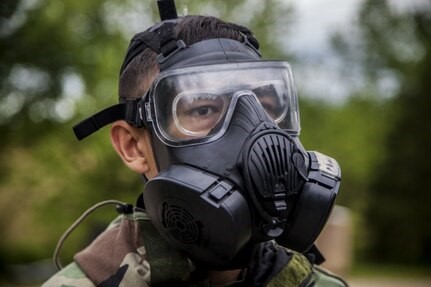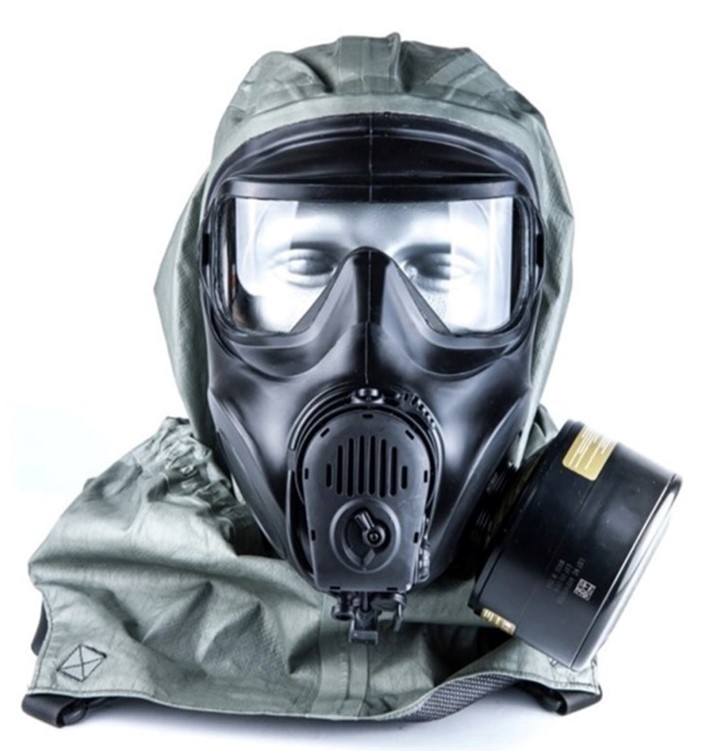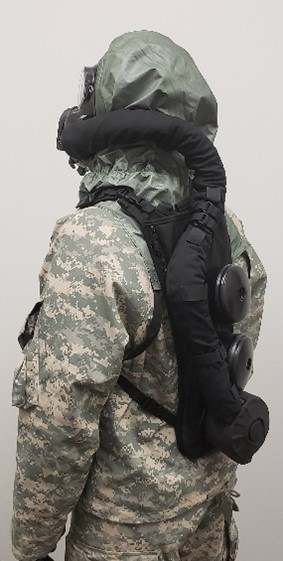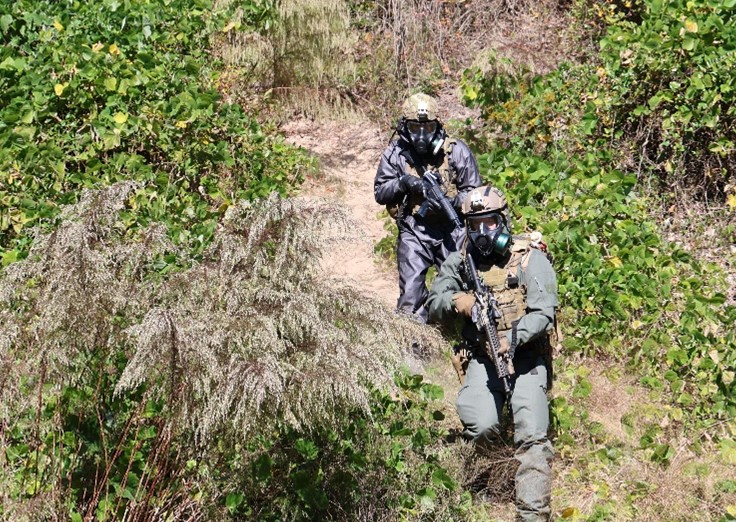Modern warfighters face various biological and chemical threats on the battlefield, from disease to potential manmade poisons, and they require more protective and innovative gear to keep them safe in the varied environments they encounter. When you think of a CBRN protective mask, most people visualize one of the currently fielded masks, such as the M50 or M51, which is a large black mask with two filter canisters on each side of the mask (see image below for reference). These are the masks that most warfighters across the services are fielded for a protective ground mask. The M51 variant has additional components and is fielded for wear inside certain combat vehicles, it’s designed to connect to air supplies within the vehicles and avoids having to switch masks for these warfighters.
Between the M50 and M51 masks, the Joint Program Executive for Chemical, Biological, Radiological and Nuclear Defense’s (JPEO-CBRND) Joint Project Manager for CBRN Protection (JPM CBRN Protection) has fielded approximately 1.7 million masks. Mask protection is used by the joint force to prevent and mitigate battlefield exposure to chemical-biological agents, toxins, Toxic Industrial Materials and radioactive particulate matter. Over the past several years there have been several innovations made to mask protection and development to ensure additional protection, reduce the physical burden of the gear and unencumber our warfighters in denied CBRN environments. JPM CBRN Protection recently fielded another mask variation for the Special Forces, CBRN and EOD communities, called the M53A1, which will lessen the physical burden and provide enhanced CBRN protection capability.
 Figure 1 - A U.S. Marine assigned to Chemical Biological Radiological and Nuclear (CBRN) Defense School, wears his M50 joint service general-purpose mask during a field training exercise at Fort Leonard Wood, Mo., May 11, 2016
Figure 1 - A U.S. Marine assigned to Chemical Biological Radiological and Nuclear (CBRN) Defense School, wears his M50 joint service general-purpose mask during a field training exercise at Fort Leonard Wood, Mo., May 11, 2016
The M53 chemical and biological protective mask system is a large black individually worn mask with an air filter canister only on one side. The M53 mask was designed with direct feedback from the Special Operations Forces (SOF) community and their distinct mission needs; this is why there is only a filter on one side of the mask, allowing for better aim when shooting a rifle and to interface with powered air-purifying respirators (PAPRs) and self-contained breathing apparatus (SCBA).
The M53 mask was developed under SOCOM on the M50 mask’s frame and was transferred to the JPEO-CBRND for advanced development. JPM CBRN Protection leveraged some of the lessons learned from the M50 design to complete the M53 approval process and product testing. The M53 mask was transferred to the JPEO-CBRND for lifecycle management, after initial fielding. The M53A1 was developed to achieve NIOSH certification of a military mask.
The M53A1 is a variation on the SOF M53 mask and is a combo system including three modes of respiration support (air-purifying respirator (APR), PAPR, and SCBA) to provide clean air in CBRN and noxious environments. The M53A1 is not replacing the M50 or M51 but will be fielded to niche units with specific needs for CBRND ground protection with respirator capabilities will now have the M53A1 at their disposal.
The new M53A1 includes a new configuration for going between respirator functions, allowing service members to select which mode they want to use with a dial, and it can go between different mission profile requirements with ease. Both the M53 and M53A1 can be used with a combination system or CS-PAPR that allows for switching operation modes without removing and reassembling equipment. The PAPR fits like a backpack and can integrate a hydration system too.
These innovations give service members options and variability in terms of what environments and capabilities they need in a single piece of protective gear. These features are game changing for many SOF service members because this allows them to adapt on the fly, a critical need for SOF operators. As well, the M53A1 provides better protection for domestic support missions with up to 24-hours of respiration support.
 Figure 2 - This is the M53A1 mask designed for special mission needs and to support domestic and military needs
Figure 2 - This is the M53A1 mask designed for special mission needs and to support domestic and military needs
Another exciting milestone the M53A1 has accomplished for the joint force is the M53A1 is the first ground mask to be approved for both domestic response, meaning the mask is NIOSH certified, and for military missions. This is helpful within the Defense Department (DOD) and CBRND first responders, this mask will allow more agility and wider use across the services for a single mask and respirator system. Additionally, the reduction in training and carrying multiple systems delivers cost and time savings while easing logistics burdens. It goes without saying that service members’ familiarity with a single system that can meet many protection needs saves valuable time to mitigate threats the joint force faces in field.
The M53A1 mask variant has reached its Production and Deployment phase of the acquisition and fielding process and met their original baseline Full Operational Capacity (FOC) in September of 2023. The original FOC requirement was a little more than 15,000 masks across the SOF community, close combat forces and the Army National Guard. This is no small feat though, the JPM CBRN Protection team has overcome many challenges while developing and fielding the M53A1 mask.
 Figure 3 - View of the M53A1 mask from the rear with breathing and hydration system
Figure 3 - View of the M53A1 mask from the rear with breathing and hydration system
The fielding timeline was scheduled to begin in March 2020 – and COVID-19 was a hurdle they had to face and overcome to meet their fielding milestones. The team was in Korea in May of 2023 fielding the masks. The M53A1 masks were originally intended to field to the Korean units as a priority but in the face of travel restrictions and shutdowns other plans had to be made. COVID-19 also hampered the team’s efforts on the production line, with textile manufacturing delays to work though in the thick of COVID.
To make up for the various delays and challenges the team was hardworking and resilient to ensure they could stay on track with the fielding milestone timeline. “COVID tried to take us down, but we still managed to accelerate our fielding timelines to meet FOC and outfit the SOCOM and Army CBRN community with the critical gear they need” said Maureen Jacobs, Product Manager for JPM CBRN Protection.
 Figure 4 - Two soldiers execute a training drill wearing their M53 masks and CBRN protective gear
Figure 4 - Two soldiers execute a training drill wearing their M53 masks and CBRN protective gear